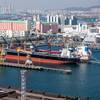Lifting Costa Concordia
Ropes made with Dyneema help Titan Salvage, Micoperi on historic salvage operation
The largest and most complex maritime salvage operation ever carried out was concluded this summer. The Costa Concordia parbuckling operation on the rocks of the Italian island of Giglio has been a success in many ways—not least for the objective to retrieve in one piece, such a massive vessel (117,000 tons) with minimal damage to the delicate marine environment on which it foundered.
High performance ropes with Dyneema played a key role in the operation.
DSM Dyneema has been supplying UHMWPE fiber, branded as Dyneema for ropes used in tug and salvage operations for almost 15 years. Ropes made with Dyneema have been used to pull stricken ships stranded in shallow waters, as well as oil platforms damaged in hurricanes, to safety all around the world. But the Costa Concordia project was probably the company’s most critical—certainly its most high-profile—salvage project to date.
DSM Dyneema’s strategy is to enable large and complex jobs to be carried out with increased safety and reliability, said Kedar Sule, Global Marketing Manager at DSM Dyneema, and the Costa Concordia salvage operation is the ultimate example of this strategy working in practice. “This is the biggest salvage operation carried out by anybody, anywhere,” said Sule. “Never before has a ship of this size been salvaged in one piece. Normally wrecks are cut up and the pieces are then removed, but that was not an option in this case due to the location and its environmental sensitivity.”
Steel wire rope remains the most commonly used product in salvage operations, followed by polyester rope. High modulus polyethylene (HMPE), accounts for a small portion of the market, but its importance in critical and environmentally critical operations is being increasingly recognized. For the Costa Concordia salvage operation, Titan Salvage and Micoperi ruled out the use of steel because of the high risk of damage it would cause to the sea floor, and to reduce the total weight of the parbuckling system.
“Many tug operators trust and use Dyneema,” said Sule. “We think its successful use in the Costa Concordia operation will reinforce the trust in our fiber.”
Minimizing Environmental Impact
Titan-Micoperi realized early on that any ropes required for the creation of the holdback system, to hold the wreck in place and then help bring it upright, would rub along the sea floor. As is well known, the Costa Concordia went aground in an area of great natural beauty where the underwater ecosystem is very precious. So it was imperative that any further damage to the ecosystem, beyond that caused by the ship itself running aground, be kept to a minimum. For this reason, the decision was made to go for a rope system that is not only extremely strong, but also very light and easy to handle. As Dyneema has neutral buoyancy in water, the ropes are easy to pull through the water by divers. Nick Sloane, the salvage master for the project, estimates that installation of the ropes, including pulling into position and connections at each end, saved around two weeks compared to if steel ropes had been used.
During the installation process, the ropes with Dyneema did indeed not drag along the seabed as steel ropes would have done. Nevertheless, since they are in constant contact along much of their length with the hull of the ship, they need surface protection, which is why Dextron 12 Plus ropes with patented protective jackets from leading Norwegian rope maker Offshore and Trawl Supply (OTS) were chosen. “With this solution, the rope cores are kept safer, as is the local ecosystem,” said Sule. The covers for the Costa Concordia project contain a reflective additive so that they can easily be seen by divers working with torches in the dark.
The Costa Concordia operation provided OTS with its largest single order. For the Costa Concordia project, core and jacket are made in two different grades of Dyneema.
Vebjørn Løviknes, Sales and Marketing Manager at OTS, said the OTS Protective Jacket “is probably the best synthetic protective cover for HMPE ropes in the market today.”
In all, there were 22 Dextron 12 Plus ropes holding the Costa Concordia, two running from each of the 11 towers mounted on the sea floor along the starboard (shore-side) side of the ship and connecting to chains that run under the hull and which are attached to the far (port) side. All the ropes have the same diameter, but each has a different length, of between 40 and 55m.
“Most of the work for DSM Dyneema was in the run-up to the production of the ropes,” said Sule. “None of us had been involved before in an operation of this scale, and we only had one chance to get it right. With this support, OTS was able to determine the construction, length and size of ropes needed to withstand the massive forces that would come into play during the holding and parbuckling operations. OTS was able to manufacture exact lengths of the ropes with great precision.”
Containing the Creep
This may sound relatively simple, it is not. The mechanism in each tower for pulling the ropes during the parbuckling operation does not involve winding the ropes around a mandrel, but rather a long hydraulic cylinder exerting a pull in a single stroke. This means that there was no room for any slack in the ropes to be taken up. Furthermore, since the ropes were to be loaded for a prolonged period of time, creep had to be considered.
Creep is a phenomenon that occurs very slowly, but in the Costa Concordia salvage operation creep was going to be measurable over the several months that the ropes were holding the ship in place, and so it needed to be calculated in advance. Even though creep is a well-known phenomenon, it is complex to predict, since it depends on multiple parameters. However, DSM Dyneema has developed a model that can accurately predict this irreversible elongation over the period of the salvage operation.
Marc Eijssen, Senior Application Manager, Offshore & Industrial at DSM Dyneema, said the company carried out a series of creep evaluations using its in-house model to predict creep under a variety of load and temperature scenarios. Based on these models, Titan-Micoperi and OTS were able to calculate the exact length needed for each rope. As is clear to see, the model proved accurate, and the parbuckling operation went exactly according to plan.
“We are used to dealing with major projects, even if nothing compares to the scale of this particular operation,” said Eijssen. “We have a lot of experience in marine applications and many salvage companies are used to working with Dyneema, and they provide us with important feedback. But each case has its own specific requirements. We rely on our years of experience and technical expertise and strong partnerships to provide the right solution in each specific case.”
“OTS was required to produce ropes with a breaking load of 1,100 tons,” Eijssen said. “When the parbuckling operation was carried out in September, the vessel had been stuck on the rocks for 20 months, during which time its structure could have seriously deteriorated. We couldn’t have it breaking up during the parbuckling operation, so each line had to fully contribute to avoid any chance of other lines being overloaded.”
As already indicated, safeguarding the subsea environment was crucial to the total salvage operation. Said Eijssen, “Titan-Micoperi had originally considered constructing the holdback system using steel rope, despite its weight and handling disadvantages, and when its people saw early concepts from OTS based on Dyneema, they weren’t convinced that a Dyneema solution would work.
But following discussions with OTS at a salvage conference, they became convinced that ropes with a patented protective cover to protect the load-bearing core were the way to go.” At this point, OTS informed Nick Sloane that DSM Dyneema were ready and willing to provide full support for the project.
Sloane has in fact worked with ropes made with Dyneema for over 10 years.
“I personally find it an ideal component for salvage intervention,” he said. “The lines with Dyneema were under the ‘shadow’ of the Costa Concordia, as she lay on her starboard side. The seabed slope and uneven terrain meant we required something light and that would not snag on the seabed - and that could be installed by a diver intervention to the turn of the Concordia bilge.”
“We preloaded the ropes to 500 tons each in a complete system test. On the actual day of the parbuckling, the forces required to hold the keel of the ship in position were limited to around 170 to 200 tons, to allow for slight shock-loads to be absorbed by the system through the operation.”
After the parbuckling phase was completed, the ropes were kept attached to the wreck to hold it in position while sponsons were attached to the starboard side before it is refloated and then removed from Giglio.
“We have a live monitoring of the loads in play on each hold-back component,” Sloane said. “We ‘swim’ the hold-back system with an ROV every 10 days to inspect the systems, but to date the loads have remained reasonably static and the system continues to work.”
“The choice of the ropes with Dyneema, along with the OTS abrasive resistant outer protection coat, has resulted in a system that met our needs exactly on a very vital part of the parbuckling operation. The performance allowed us to carry out the operation without having to worry about a failure of the holdback system, and focus on the offshore side of the parbuckling components which required continual monitoring and adjustments.”
(As published in the November 2014 edition of Maritime Reporter & Engineering News - http://magazines.marinelink.com/Magazines/MaritimeReporter)











